2017 NISSAN ROGUE HYBRID flat tire
[x] Cancel search: flat tirePage 33 of 77
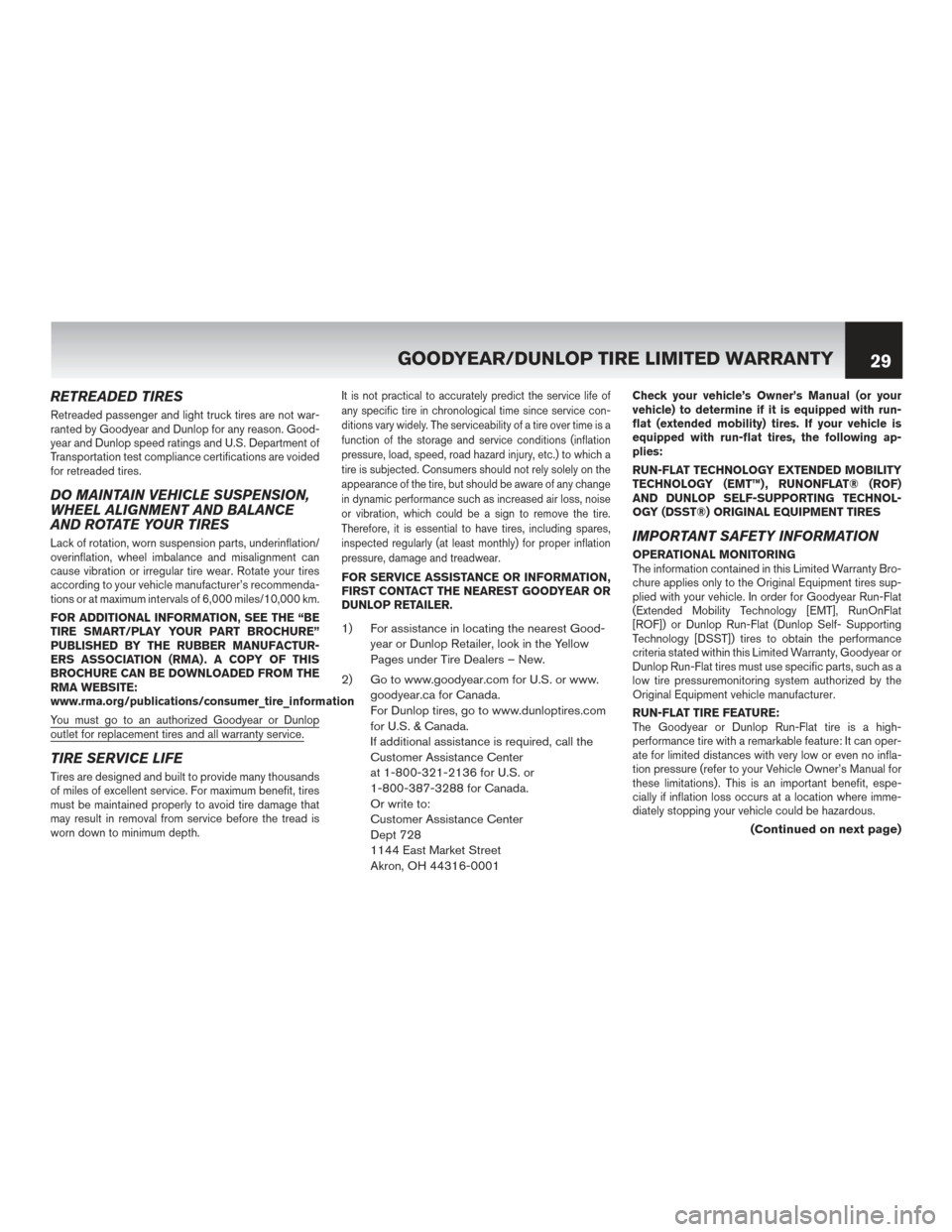
RETREADED TIRES
Retreaded passenger and light truck tires are not war-
ranted by Goodyear and Dunlop for any reason. Good-
year and Dunlop speed ratings and U.S. Department of
Transportation test compliance certifications are voided
for retreaded tires.
DO MAINTAIN VEHICLE SUSPENSION,
WHEEL ALIGNMENT AND BALANCE
AND ROTATE YOUR TIRES
Lack of rotation, worn suspension parts, underinflation/
overinflation, wheel imbalance and misalignment can
cause vibration or irregular tire wear. Rotate your tires
according to your vehicle manufacturer’s recommenda-
tions or at maximum intervals of 6,000 miles/10,000 km.
FOR ADDITIONAL INFORMATION, SEE THE “BE
TIRE SMART/PLAY YOUR PART BROCHURE”
PUBLISHED BY THE RUBBER MANUFACTUR-
ERS ASSOCIATION (RMA) . A COPY OF THIS
BROCHURE CAN BE DOWNLOADED FROM THE
RMA WEBSITE:
www.rma.org/publications/consumer_tire_information
You must go to an authorized Goodyear or Dunlop
outlet for replacement tires and all warranty service.
TIRE SERVICE LIFE
Tires are designed and built to provide many thousands
of miles of excellent service. For maximum benefit, tires
must be maintained properly to avoid tire damage that
may result in removal from service before the tread is
worn down to minimum depth.
It is not practical to accurately predict the service life of
any specific tire in chronological time since service con-
ditions vary widely. The serviceability of a tire over time is a
function of the storage and service conditions (inflation
pressure, load, speed, road hazard injury, etc.) to which a
tire is subjected. Consumers should not rely solely on the
appearance of the tire, but should be aware of any change
in dynamic performance such as increased air loss, noise
or vibration, which could be a sign to remove the tire.
Therefore, it is essential to have tires, including spares,
inspected regularly (at least monthly) for proper inflation
pressure, damage and treadwear.
FOR SERVICE ASSISTANCE OR INFORMATION,
FIRST CONTACT THE NEAREST GOODYEAR OR
DUNLOP RETAILER.
1) For assistance in locating the nearest Good-year or Dunlop Retailer, look in the Yellow
Pages under Tire Dealers – New.
2) Go to www.goodyear.com for U.S. or www. goodyear.ca for Canada.
For Dunlop tires, go to www.dunloptires.com
for U.S. & Canada.
If additional assistance is required, call the
Customer Assistance Center
at 1-800-321-2136 for U.S. or
1-800-387-3288 for Canada.
Or write to:
Customer Assistance Center
Dept 728
1144 East Market Street
Akron, OH 44316-0001
Check your vehicle’s Owner’s Manual (or your
vehicle) to determine if it is equipped with run-
flat (extended mobility) tires. If your vehicle is
equipped with run-flat tires, the following ap-
plies:
RUN-FLAT TECHNOLOGY EXTENDED MOBILITY
TECHNOLOGY (EMT™) , RUNONFLAT® (ROF)
AND DUNLOP SELF-SUPPORTING TECHNOL-
OGY (DSST®) ORIGINAL EQUIPMENT TIRES
IMPORTANT SAFETY INFORMATION
OPERATIONAL MONITORING
The information contained in this Limited Warranty Bro-
chure applies only to the Original Equipment tires sup-
plied with your vehicle. In order for Goodyear Run-Flat
(Extended Mobility Technology [EMT], RunOnFlat
[ROF]) or Dunlop Run-Flat (Dunlop Self- Supporting
Technology [DSST]) tires to obtain the performance
criteria stated within this Limited Warranty, Goodyear or
Dunlop Run-Flat tires must use specific parts, such as a
low tire pressuremonitoring system authorized by the
Original Equipment vehicle manufacturer.
RUN-FLAT TIRE FEATURE:
The Goodyear or Dunlop Run-Flat tire is a high-
performance tire with a remarkable feature: It can oper-
ate for limited distances with very low or even no infla-
tion pressure (refer to your Vehicle Owner’s Manual for
these limitations) . This is an important benefit, espe-
cially if inflation loss occurs at a location where imme-
diately stopping your vehicle could be hazardous.
(Continued on next page)
GOODYEAR/DUNLOP TIRE LIMITED WARRANTY 29
Page 34 of 77
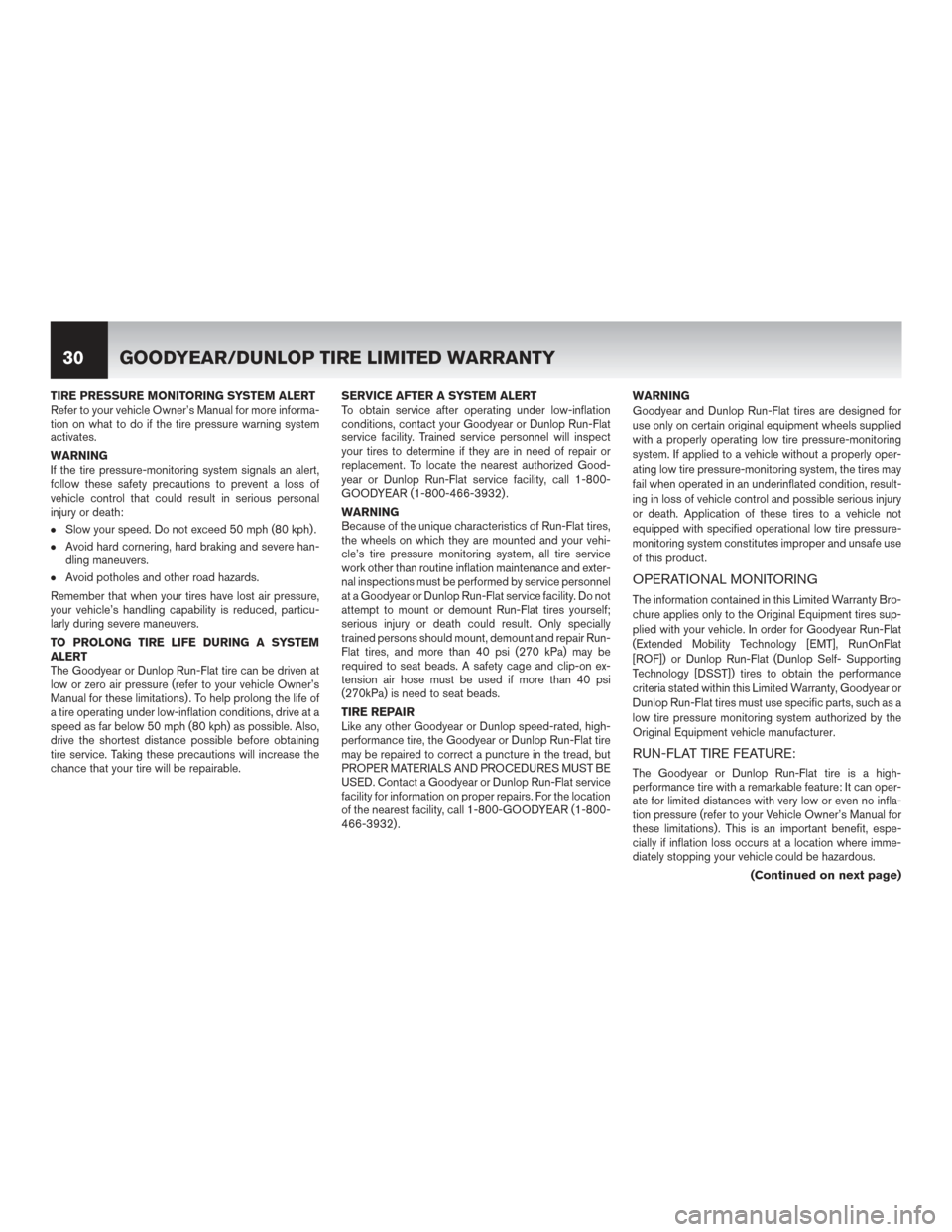
TIRE PRESSURE MONITORING SYSTEM ALERT
Refer to your vehicle Owner’s Manual for more informa-
tion on what to do if the tire pressure warning system
activates.
WARNING
If the tire pressure-monitoring system signals an alert,
follow these safety precautions to prevent a loss of
vehicle control that could result in serious personal
injury or death:
●Slow your speed. Do not exceed 50 mph (80 kph) .
●Avoid hard cornering, hard braking and severe han-
dling maneuvers.
●Avoid potholes and other road hazards.
Remember that when your tires have lost air pressure,
your vehicle’s handling capability is reduced, particu-
larly during severe maneuvers.
TO PROLONG TIRE LIFE DURING A SYSTEM
ALERT
The Goodyear or Dunlop Run-Flat tire can be driven at
low or zero air pressure (refer to your vehicle Owner’s
Manual for these limitations) . To help prolong the life of
a tire operating under low-inflation conditions, drive at a
speed as far below 50 mph (80 kph) as possible. Also,
drive the shortest distance possible before obtaining
tire service. Taking these precautions will increase the
chance that your tire will be repairable. SERVICE AFTER A SYSTEM ALERT
To obtain service after operating under low-inflation
conditions, contact your Goodyear or Dunlop Run-Flat
service facility. Trained service personnel will inspect
your tires to determine if they are in need of repair or
replacement. To locate the nearest authorized Good-
year or Dunlop Run-Flat service facility, call 1-800-
GOODYEAR (1-800-466-3932) .
WARNING
Because of the unique characteristics of Run-Flat tires,
the wheels on which they are mounted and your vehi-
cle’s tire pressure monitoring system, all tire service
work other than routine inflation maintenance and exter-
nal inspections must be performed by service personnel
at a Goodyear or Dunlop Run-Flat service facility. Do not
attempt to mount or demount Run-Flat tires yourself;
serious injury or death could result. Only specially
trained persons should mount, demount and repair Run-
Flat tires, and more than 40 psi (270 kPa) may be
required to seat beads. A safety cage and clip-on ex-
tension air hose must be used if more than 40 psi
(270kPa) is need to seat beads.
TIRE REPAIR
Like any other Goodyear or Dunlop speed-rated, high-
performance tire, the Goodyear or Dunlop Run-Flat tire
may be repaired to correct a puncture in the tread, but
PROPER MATERIALS AND PROCEDURES MUST BE
USED. Contact a Goodyear or Dunlop Run-Flat service
facility for information on proper repairs. For the location
of the nearest facility, call 1-800-GOODYEAR (1-800-
466-3932) .WARNING
Goodyear and Dunlop Run-Flat tires are designed for
use only on certain original equipment wheels supplied
with a properly operating low tire pressure-monitoring
system. If applied to a vehicle without a properly oper-
ating low tire pressure-monitoring system, the tires may
fail when operated in an underinflated condition, result-
ing in loss of vehicle control and possible serious injury
or death. Application of these tires to a vehicle not
equipped with specified operational low tire pressure-
monitoring system constitutes improper and unsafe use
of this product.OPERATIONAL MONITORING
The information contained in this Limited Warranty Bro-
chure applies only to the Original Equipment tires sup-
plied with your vehicle. In order for Goodyear Run-Flat
(Extended Mobility Technology [EMT], RunOnFlat
[ROF]) or Dunlop Run-Flat (Dunlop Self- Supporting
Technology [DSST]) tires to obtain the performance
criteria stated within this Limited Warranty, Goodyear or
Dunlop Run-Flat tires must use specific parts, such as a
low tire pressure monitoring system authorized by the
Original Equipment vehicle manufacturer.
RUN-FLAT TIRE FEATURE:
The Goodyear or Dunlop Run-Flat tire is a high-
performance tire with a remarkable feature: It can oper-
ate for limited distances with very low or even no infla-
tion pressure (refer to your Vehicle Owner’s Manual for
these limitations) . This is an important benefit, espe-
cially if inflation loss occurs at a location where imme-
diately stopping your vehicle could be hazardous.
(Continued on next page)
30
GOODYEAR/DUNLOP TIRE LIMITED WARRANTY
Page 35 of 77
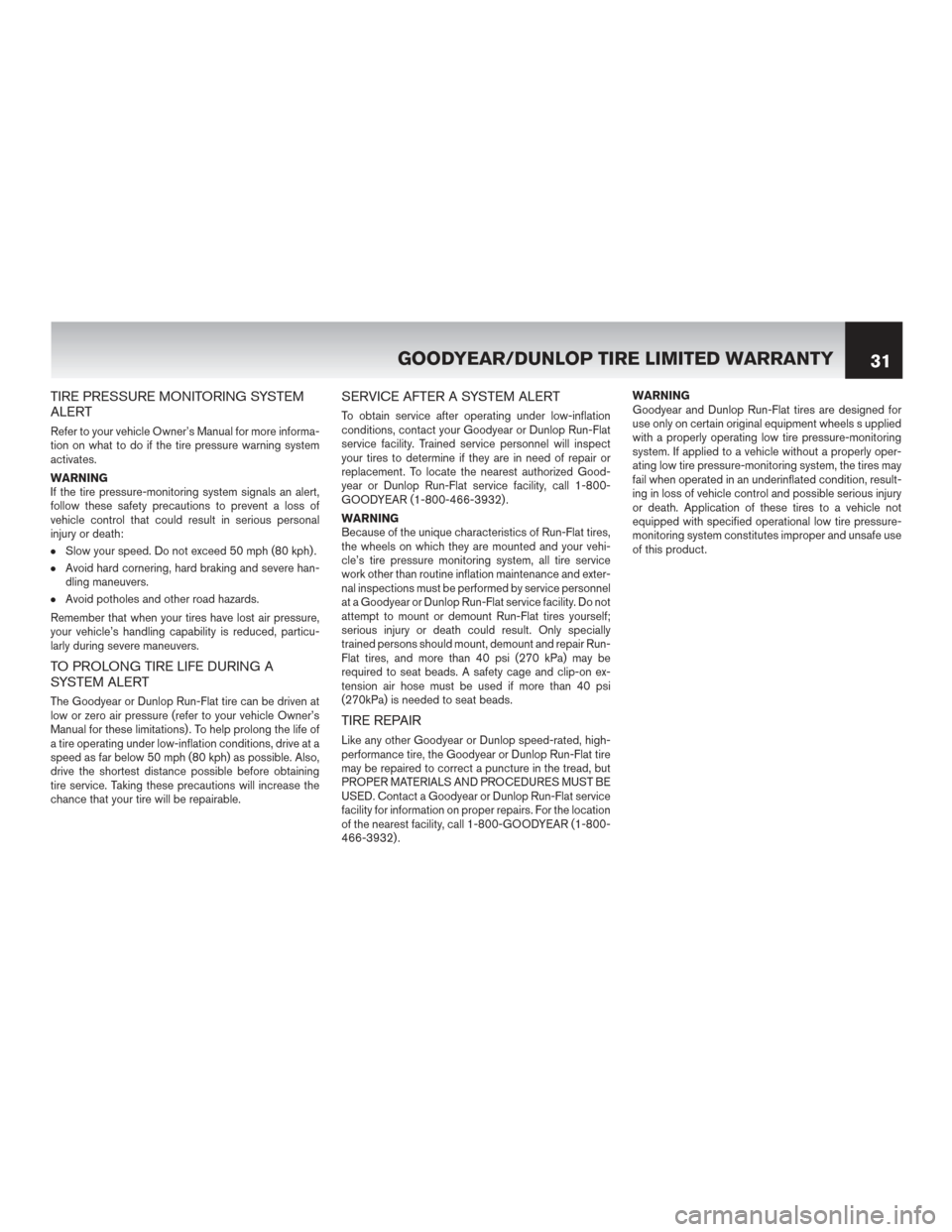
TIRE PRESSURE MONITORING SYSTEM
ALERT
Refer to your vehicle Owner’s Manual for more informa-
tion on what to do if the tire pressure warning system
activates.
WARNING
If the tire pressure-monitoring system signals an alert,
follow these safety precautions to prevent a loss of
vehicle control that could result in serious personal
injury or death:
●Slow your speed. Do not exceed 50 mph (80 kph) .
●Avoid hard cornering, hard braking and severe han-
dling maneuvers.
●Avoid potholes and other road hazards.
Remember that when your tires have lost air pressure,
your vehicle’s handling capability is reduced, particu-
larly during severe maneuvers.
TO PROLONG TIRE LIFE DURING A
SYSTEM ALERT
The Goodyear or Dunlop Run-Flat tire can be driven at
low or zero air pressure (refer to your vehicle Owner’s
Manual for these limitations) . To help prolong the life of
a tire operating under low-inflation conditions, drive at a
speed as far below 50 mph (80 kph) as possible. Also,
drive the shortest distance possible before obtaining
tire service. Taking these precautions will increase the
chance that your tire will be repairable.
SERVICE AFTER A SYSTEM ALERT
To obtain service after operating under low-inflation
conditions, contact your Goodyear or Dunlop Run-Flat
service facility. Trained service personnel will inspect
your tires to determine if they are in need of repair or
replacement. To locate the nearest authorized Good-
year or Dunlop Run-Flat service facility, call 1-800-
GOODYEAR (1-800-466-3932) .
WARNING
Because of the unique characteristics of Run-Flat tires,
the wheels on which they are mounted and your vehi-
cle’s tire pressure monitoring system, all tire service
work other than routine inflation maintenance and exter-
nal inspections must be performed by service personnel
at a Goodyear or Dunlop Run-Flat service facility. Do not
attempt to mount or demount Run-Flat tires yourself;
serious injury or death could result. Only specially
trained persons should mount, demount and repair Run-
Flat tires, and more than 40 psi (270 kPa) may be
required to seat beads. A safety cage and clip-on ex-
tension air hose must be used if more than 40 psi
(270kPa) is needed to seat beads.
TIRE REPAIR
Like any other Goodyear or Dunlop speed-rated, high-
performance tire, the Goodyear or Dunlop Run-Flat tire
may be repaired to correct a puncture in the tread, but
PROPER MATERIALS AND PROCEDURES MUST BE
USED. Contact a Goodyear or Dunlop Run-Flat service
facility for information on proper repairs. For the location
of the nearest facility, call 1-800-GOODYEAR (1-800-
466-3932) . WARNING
Goodyear and Dunlop Run-Flat tires are designed for
use only on certain original equipment wheels s upplied
with a properly operating low tire pressure-monitoring
system. If applied to a vehicle without a properly oper-
ating low tire pressure-monitoring system, the tires may
fail when operated in an underinflated condition, result-
ing in loss of vehicle control and possible serious injury
or death. Application of these tires to a vehicle not
equipped with specified operational low tire pressure-
monitoring system constitutes improper and unsafe use
of this product.
GOODYEAR/DUNLOP TIRE LIMITED WARRANTY
31
Page 39 of 77
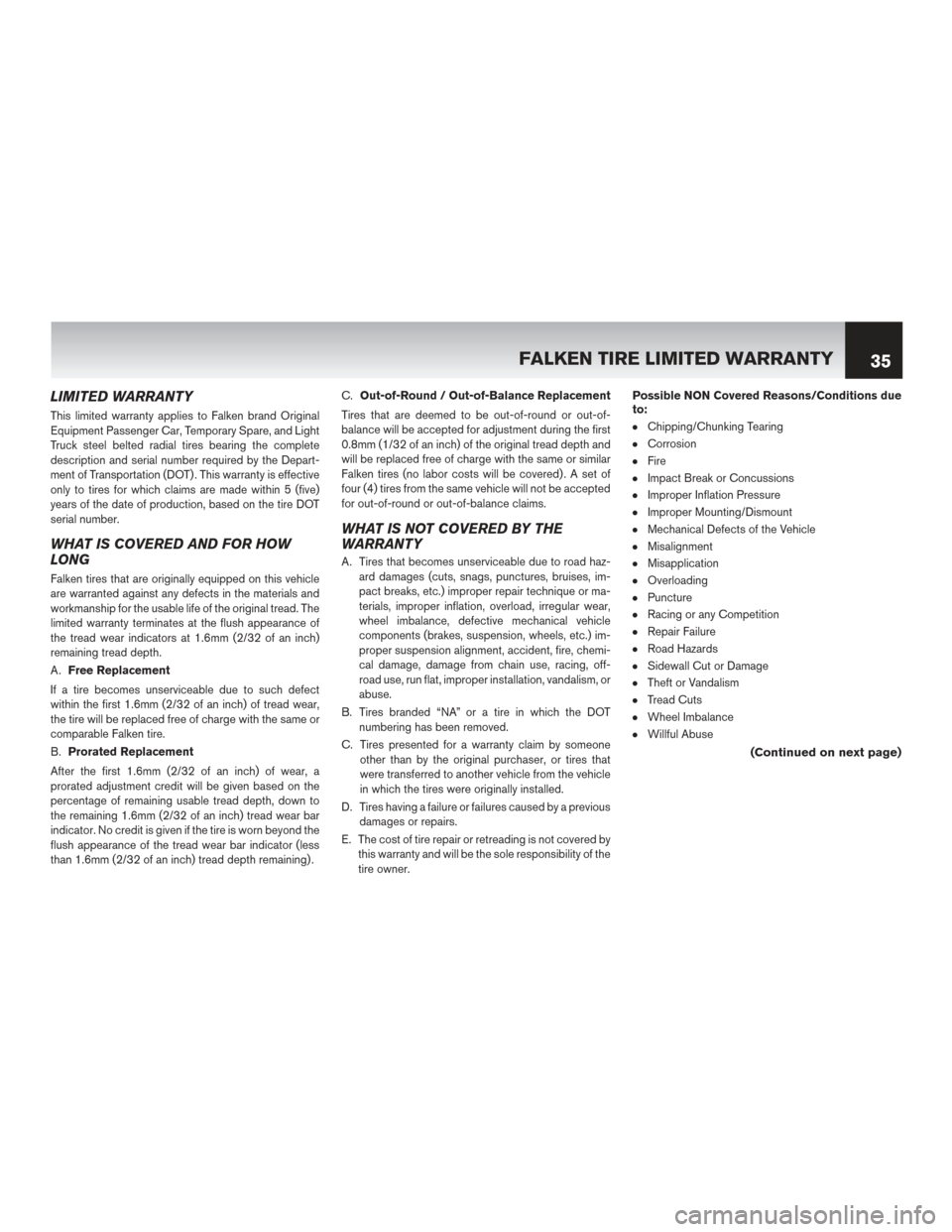
LIMITED WARRANTY
This limited warranty applies to Falken brand Original
Equipment Passenger Car, Temporary Spare, and Light
Truck steel belted radial tires bearing the complete
description and serial number required by the Depart-
ment of Transportation (DOT) . This warranty is effective
only to tires for which claims are made within 5 (five)
years of the date of production, based on the tire DOT
serial number.
WHAT IS COVERED AND FOR HOW
LONG
Falken tires that are originally equipped on this vehicle
are warranted against any defects in the materials and
workmanship for the usable life of the original tread. The
limited warranty terminates at the flush appearance of
the tread wear indicators at 1.6mm (2/32 of an inch)
remaining tread depth.
A.Free Replacement
If a tire becomes unserviceable due to such defect
within the first 1.6mm (2/32 of an inch) of tread wear,
the tire will be replaced free of charge with the same or
comparable Falken tire.
B. Prorated Replacement
After the first 1.6mm (2/32 of an inch) of wear, a
prorated adjustment credit will be given based on the
percentage of remaining usable tread depth, down to
the remaining 1.6mm (2/32 of an inch) tread wear bar
indicator. No credit is given if the tire is worn beyond the
flush appearance of the tread wear bar indicator (less
than 1.6mm (2/32 of an inch) tread depth remaining) . C.
Out-of-Round / Out-of-Balance Replacement
Tires that are deemed to be out-of-round or out-of-
balance will be accepted for adjustment during the first
0.8mm (1/32 of an inch) of the original tread depth and
will be replaced free of charge with the same or similar
Falken tires (no labor costs will be covered) . A set of
four (4) tires from the same vehicle will not be accepted
for out-of-round or out-of-balance claims.
WHAT IS NOT COVERED BY THE
WARRANTY
A. Tires that becomes unserviceable due to road haz- ard damages (cuts, snags, punctures, bruises, im-
pact breaks, etc.) improper repair technique or ma-
terials, improper inflation, overload, irregular wear,
wheel imbalance, defective mechanical vehicle
components (brakes, suspension, wheels, etc.) im-
proper suspension alignment, accident, fire, chemi-
cal damage, damage from chain use, racing, off-
road use, run flat, improper installation, vandalism, or
abuse.
B. Tires branded “NA” or a tire in which the DOT numbering has been removed.
C. Tires presented for a warranty claim by someone other than by the original purchaser, or tires that
were transferred to another vehicle from the vehicle
in which the tires were originally installed.
D. Tires having a failure or failures caused by a previous damages or repairs.
E. The cost of tire repair or retreading is not covered by this warranty and will be the sole responsibility of the
tire owner. Possible NON Covered Reasons/Conditions due
to:
●Chipping/Chunking Tearing
●Corrosion
●Fire
●Impact Break or Concussions
●Improper Inflation Pressure
●Improper Mounting/Dismount
●Mechanical Defects of the Vehicle
●Misalignment
●Misapplication
●Overloading
●Puncture
●Racing or any Competition
●Repair Failure
●Road Hazards
●Sidewall Cut or Damage
●Theft or Vandalism
●Tread Cuts
●Wheel Imbalance
●Willful Abuse
(Continued on next page)
FALKEN TIRE LIMITED WARRANTY
35
Page 40 of 77
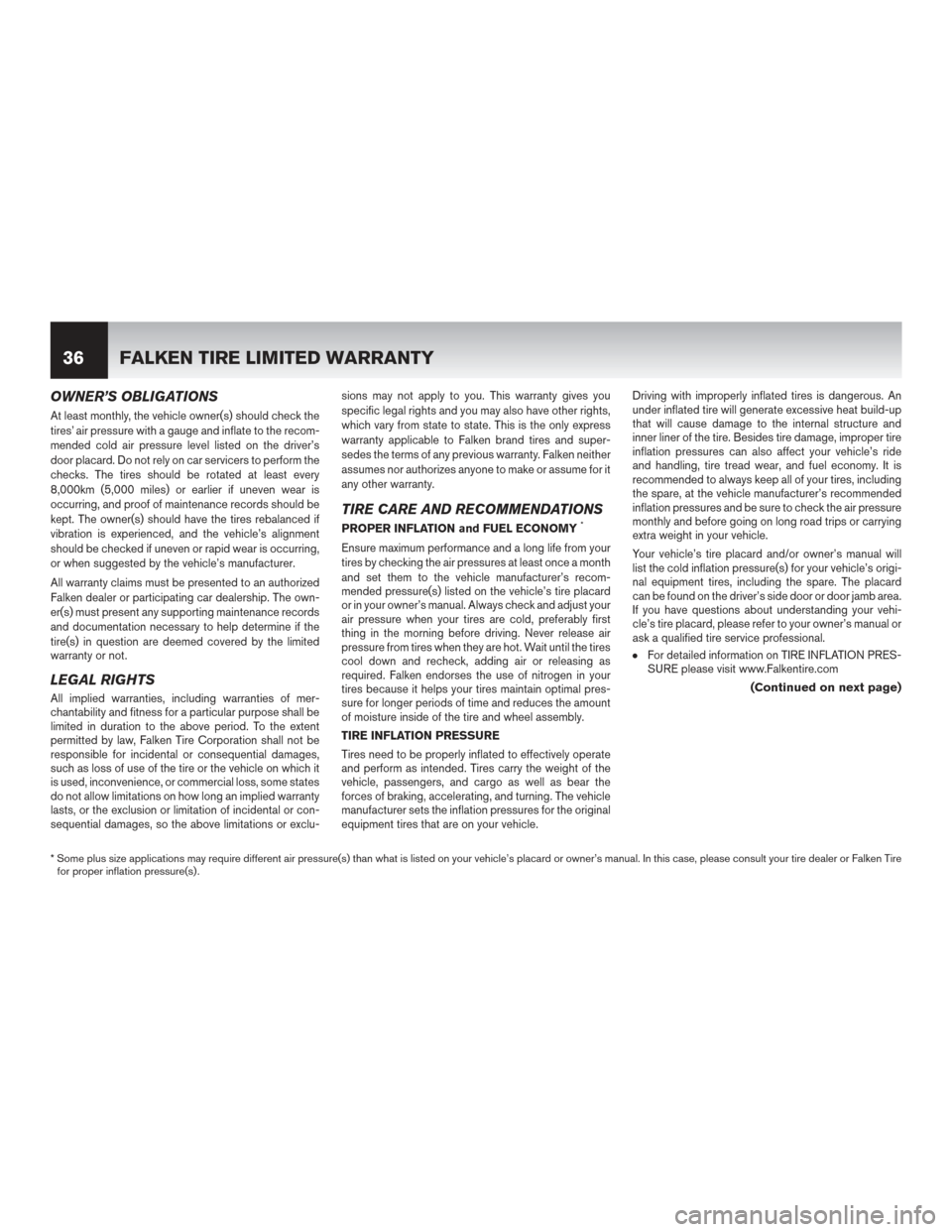
OWNER’S OBLIGATIONS
At least monthly, the vehicle owner(s) should check the
tires’ air pressure with a gauge and inflate to the recom-
mended cold air pressure level listed on the driver’s
door placard. Do not rely on car servicers to perform the
checks. The tires should be rotated at least every
8,000km (5,000 miles) or earlier if uneven wear is
occurring, and proof of maintenance records should be
kept. The owner(s) should have the tires rebalanced if
vibration is experienced, and the vehicle’s alignment
should be checked if uneven or rapid wear is occurring,
or when suggested by the vehicle’s manufacturer.
All warranty claims must be presented to an authorized
Falken dealer or participating car dealership. The own-
er(s) must present any supporting maintenance records
and documentation necessary to help determine if the
tire(s) in question are deemed covered by the limited
warranty or not.
LEGAL RIGHTS
All implied warranties, including warranties of mer-
chantability and fitness for a particular purpose shall be
limited in duration to the above period. To the extent
permitted by law, Falken Tire Corporation shall not be
responsible for incidental or consequential damages,
such as loss of use of the tire or the vehicle on which it
is used, inconvenience, or commercial loss, some states
do not allow limitations on how long an implied warranty
lasts, or the exclusion or limitation of incidental or con-
sequential damages, so the above limitations or exclu-sions may not apply to you. This warranty gives you
specific legal rights and you may also have other rights,
which vary from state to state. This is the only express
warranty applicable to Falken brand tires and super-
sedes the terms of any previous warranty. Falken neither
assumes nor authorizes anyone to make or assume for it
any other warranty.
TIRE CARE AND RECOMMENDATIONS
PROPER INFLATION and FUEL ECONOMY*
Ensure maximum performance and a long life from your
tires by checking the air pressures at least once a month
and set them to the vehicle manufacturer’s recom-
mended pressure(s) listed on the vehicle’s tire placard
or in your owner’s manual. Always check and adjust your
air pressure when your tires are cold, preferably first
thing in the morning before driving. Never release air
pressure from tires when they are hot. Wait until the tires
cool down and recheck, adding air or releasing as
required. Falken endorses the use of nitrogen in your
tires because it helps your tires maintain optimal pres-
sure for longer periods of time and reduces the amount
of moisture inside of the tire and wheel assembly.
TIRE INFLATION PRESSURE
Tires need to be properly inflated to effectively operate
and perform as intended. Tires carry the weight of the
vehicle, passengers, and cargo as well as bear the
forces of braking, accelerating, and turning. The vehicle
manufacturer sets the inflation pressures for the original
equipment tires that are on your vehicle.Driving with improperly inflated tires is dangerous. An
under inflated tire will generate excessive heat build-up
that will cause damage to the internal structure and
inner liner of the tire. Besides tire damage, improper tire
inflation pressures can also affect your vehicle’s ride
and handling, tire tread wear, and fuel economy. It is
recommended to always keep all of your tires, including
the spare, at the vehicle manufacturer’s recommended
inflation pressures and be sure to check the air pressure
monthly and before going on long road trips or carrying
extra weight in your vehicle.
Your vehicle’s tire placard and/or owner’s manual will
list the cold inflation pressure(s) for your vehicle’s origi-
nal equipment tires, including the spare. The placard
can be found on the driver’s side door or door jamb area.
If you have questions about understanding your vehi-
cle’s tire placard, please refer to your owner’s manual or
ask a qualified tire service professional.
●For detailed information on TIRE INFLATION PRES-
SURE please visit www.Falkentire.com
(Continued on next page)
* Some plus size applications may require different air pressure(s) than what is listed on your vehicle’s placard or owner’s manual. In this case, please consult your tire dealer or Falken Tire
for proper inflation pressure(s) .
36 FALKEN TIRE LIMITED WARRANTY
Page 41 of 77
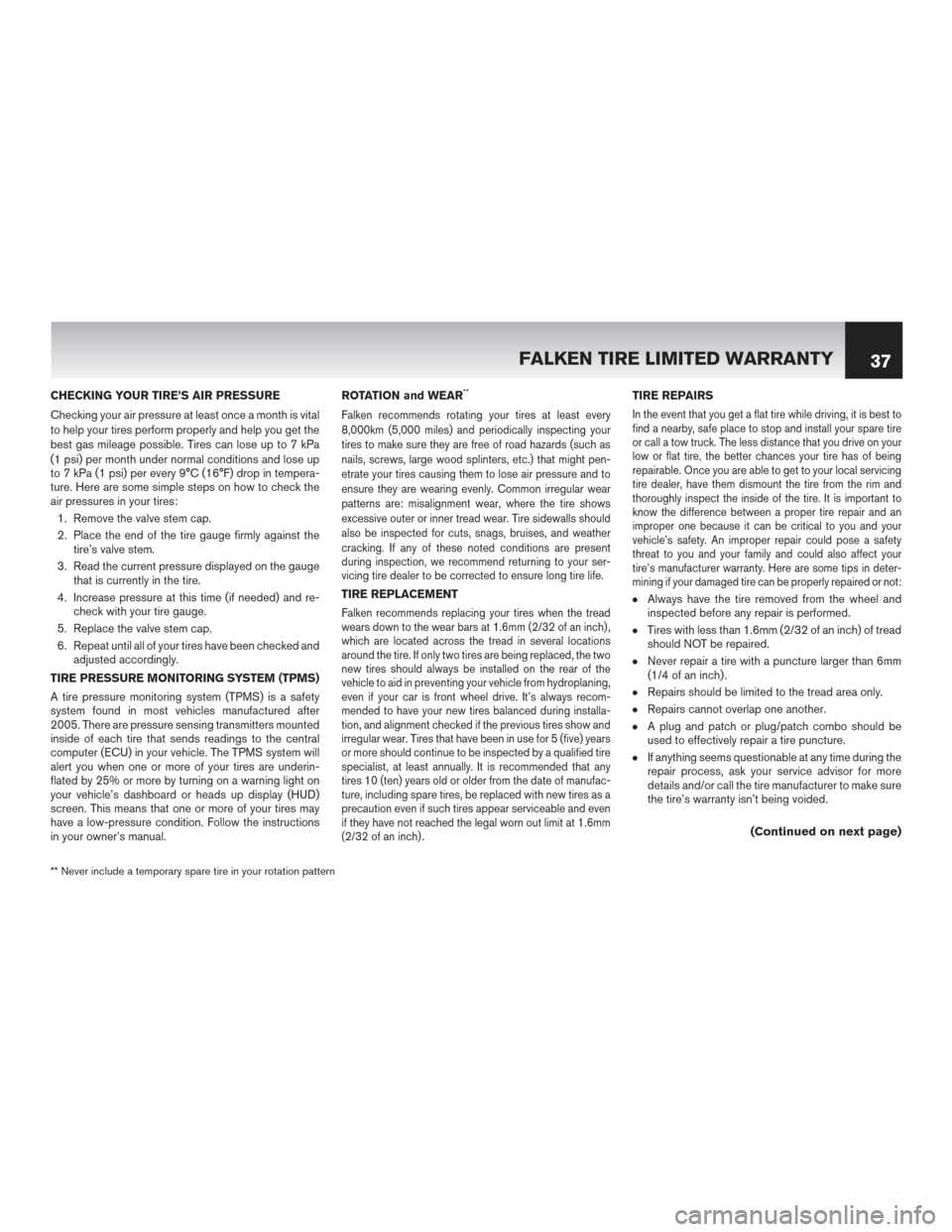
CHECKING YOUR TIRE’S AIR PRESSURE
Checking your air pressure at least once a month is vital
to help your tires perform properly and help you get the
best gas mileage possible. Tires can lose up to 7 kPa
(1 psi) per month under normal conditions and lose up
to 7 kPa (1 psi) per every 9°C (16°F) drop in tempera-
ture. Here are some simple steps on how to check the
air pressures in your tires:1. Remove the valve stem cap.
2. Place the end of the tire gauge firmly against the tire’s valve stem.
3. Read the current pressure displayed on the gauge that is currently in the tire.
4. Increase pressure at this time (if needed) and re- check with your tire gauge.
5. Replace the valve stem cap.
6. Repeat until all of your tires have been checked and adjusted accordingly.
TIRE PRESSURE MONITORING SYSTEM (TPMS)
A tire pressure monitoring system (TPMS) is a safety
system found in most vehicles manufactured after
2005. There are pressure sensing transmitters mounted
inside of each tire that sends readings to the central
computer (ECU) in your vehicle. The TPMS system will
alert you when one or more of your tires are underin-
flated by 25% or more by turning on a warning light on
your vehicle’s dashboard or heads up display (HUD)
screen. This means that one or more of your tires may
have a low-pressure condition. Follow the instructions
in your owner’s manual. ROTATION and WEAR**
Falken recommends rotating your tires at least every
8,000km (5,000 miles) and periodically inspecting your
tires to make sure they are free of road hazards (such as
nails, screws, large wood splinters, etc.) that might pen-
etrate your tires causing them to lose air pressure and to
ensure they are wearing evenly. Common irregular wear
patterns are: misalignment wear, where the tire shows
excessive outer or inner tread wear. Tire sidewalls should
also be inspected for cuts, snags, bruises, and weather
cracking. If any of these noted conditions are present
during inspection, we recommend returning to your ser-
vicing tire dealer to be corrected to ensure long tire life.
TIRE REPLACEMENT
Falken recommends replacing your tires when the tread
wears down to the wear bars at 1.6mm (2/32 of an inch) ,
which are located across the tread in several locations
around the tire. If only two tires are being replaced, the two
new tires should always be installed on the rear of the
vehicle to aid in preventing your vehicle from hydroplaning,
even if your car is front wheel drive. It’s always recom-
mended to have your new tires balanced during installa-
tion, and alignment checked if the previous tires show and
irregular wear. Tires that have been in use for 5 (five) years
or more should continue to be inspected by a qualified tire
specialist, at least annually. It is recommended that any
tires 10 (ten) years old or older from the date of manufac-
ture, including spare tires, be replaced with new tires as a
precaution even if such tires appear serviceable and even
if they have not reached the legal worn out limit at 1.6mm
(2/32 of an inch) .
TIRE REPAIRS
In the event that you get a flat tire while driving, it is best to
find a nearby, safe place to stop and install your spare tire
or call a tow truck. The less distance that you drive on your
low or flat tire, the better chances your tire has of being
repairable. Once you are able to get to your local servicing
tire dealer, have them dismount the tire from the rim and
thoroughly inspect the inside of the tire. It is important to
know the difference between a proper tire repair and an
improper one because it can be critical to you and your
vehicle’s safety. An improper repair could pose a safety
threat to you and your family and could also affect your
tire’s manufacturer warranty. Here are some tips in deter-
mining if your damaged tire can be properly repaired or not:
●Always have the tire removed from the wheel and
inspected before any repair is performed.
●Tires with less than 1.6mm (2/32 of an inch) of tread
should NOT be repaired.
●Never repair a tire with a puncture larger than 6mm
(1/4 of an inch) .
●Repairs should be limited to the tread area only.
●Repairs cannot overlap one another.
●A plug and patch or plug/patch combo should be
used to effectively repair a tire puncture.
●If anything seems questionable at any time during the
repair process, ask your service advisor for more
details and/or call the tire manufacturer to make sure
the tire’s warranty isn’t being voided.
(Continued on next page)
** Never include a temporary spare tire in your rotation pattern
FALKEN TIRE LIMITED WARRANTY 37
Page 43 of 77
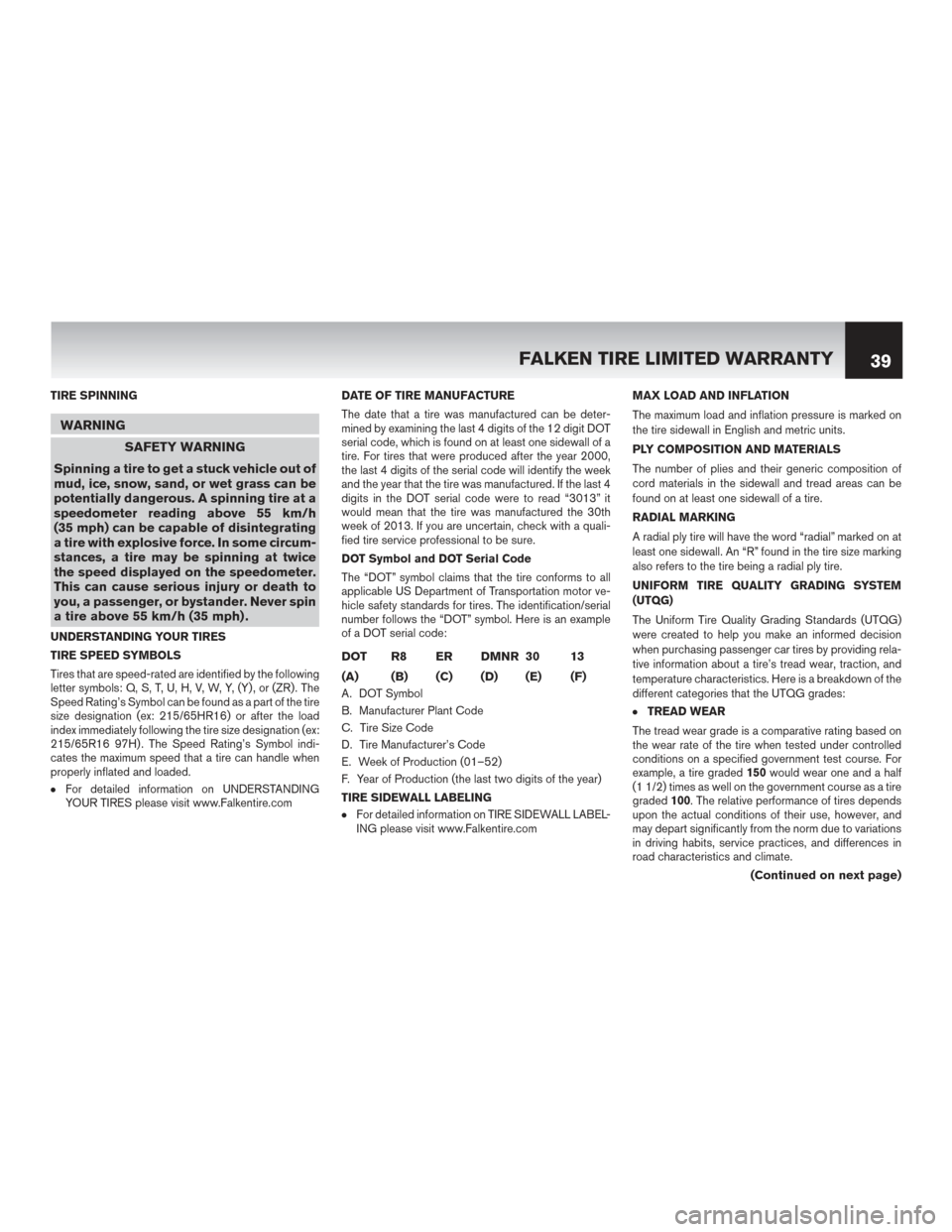
TIRE SPINNING
WARNINGSAFETY WARNING
Spinning a tire to get a stuck vehicle out of
mud, ice, snow, sand, or wet grass can be
potentially dangerous. A spinning tire at a
speedometer reading above 55 km/h
(35 mph) can be capable of disintegrating
a tire with explosive force. In some circum-
stances, a tire may be spinning at twice
the speed displayed on the speedometer.
This can cause serious injury or death to
you, a passenger, or bystander. Never spin
a tire above 55 km/h (35 mph) .
UNDERSTANDING YOUR TIRES
TIRE SPEED SYMBOLS
Tires that are speed-rated are identified by the following
letter symbols: Q, S, T, U, H, V, W, Y, (Y) , or (ZR) . The
Speed Rating’s Symbol can be found as a part of the tire
size designation (ex: 215/65HR16) or after the load
index immediately following the tire size designation (ex:
215/65R16 97H) . The Speed Rating’s Symbol indi-
cates the maximum speed that a tire can handle when
properly inflated and loaded.
●For detailed information on UNDERSTANDING
YOUR TIRES please visit www.Falkentire.com DATE OF TIRE MANUFACTURE
The date that a tire was manufactured can be deter-
mined by examining the last 4 digits of the 12 digit DOT
serial code, which is found on at least one sidewall of a
tire. For tires that were produced after the year 2000,
the last 4 digits of the serial code will identify the week
and the year that the tire was manufactured. If the last 4
digits in the DOT serial code were to read “3013” it
would mean that the tire was manufactured the 30th
week of 2013. If you are uncertain, check with a quali-
fied tire service professional to be sure.
DOT Symbol and DOT Serial Code
The “DOT” symbol claims that the tire conforms to all
applicable US Department of Transportation motor ve-
hicle safety standards for tires. The identification/serial
number follows the “DOT” symbol. Here is an example
of a DOT serial code:
DOT R8 ER DMNR 30 13
(A) (B) (C) (D) (E) (F)
A. DOT Symbol
B. Manufacturer Plant Code
C. Tire Size Code
D. Tire Manufacturer’s Code
E. Week of Production (01–52)
F. Year of Production (the last two digits of the year)
TIRE SIDEWALL LABELING
●For detailed information on TIRE SIDEWALL LABEL-
ING please visit www.Falkentire.com MAX LOAD AND INFLATION
The maximum load and inflation pressure is marked on
the tire sidewall in English and metric units.
PLY COMPOSITION AND MATERIALS
The number of plies and their generic composition of
cord materials in the sidewall and tread areas can be
found on at least one sidewall of a tire.
RADIAL MARKING
A radial ply tire will have the word “radial” marked on at
least one sidewall. An “R” found in the tire size marking
also refers to the tire being a radial ply tire.
UNIFORM TIRE QUALITY GRADING SYSTEM
(UTQG)
The Uniform Tire Quality Grading Standards (UTQG)
were created to help you make an informed decision
when purchasing passenger car tires by providing rela-
tive information about a tire’s tread wear, traction, and
temperature characteristics. Here is a breakdown of the
different categories that the UTQG grades:
●TREAD WEAR
The tread wear grade is a comparative rating based on
the wear rate of the tire when tested under controlled
conditions on a specified government test course. For
example, a tire graded 150would wear one and a half
(1 1/2) times as well on the government course as a tire
graded 100. The relative performance of tires depends
upon the actual conditions of their use, however, and
may depart significantly from the norm due to variations
in driving habits, service practices, and differences in
road characteristics and climate.
(Continued on next page)
FALKEN TIRE LIMITED WARRANTY 39
Page 44 of 77
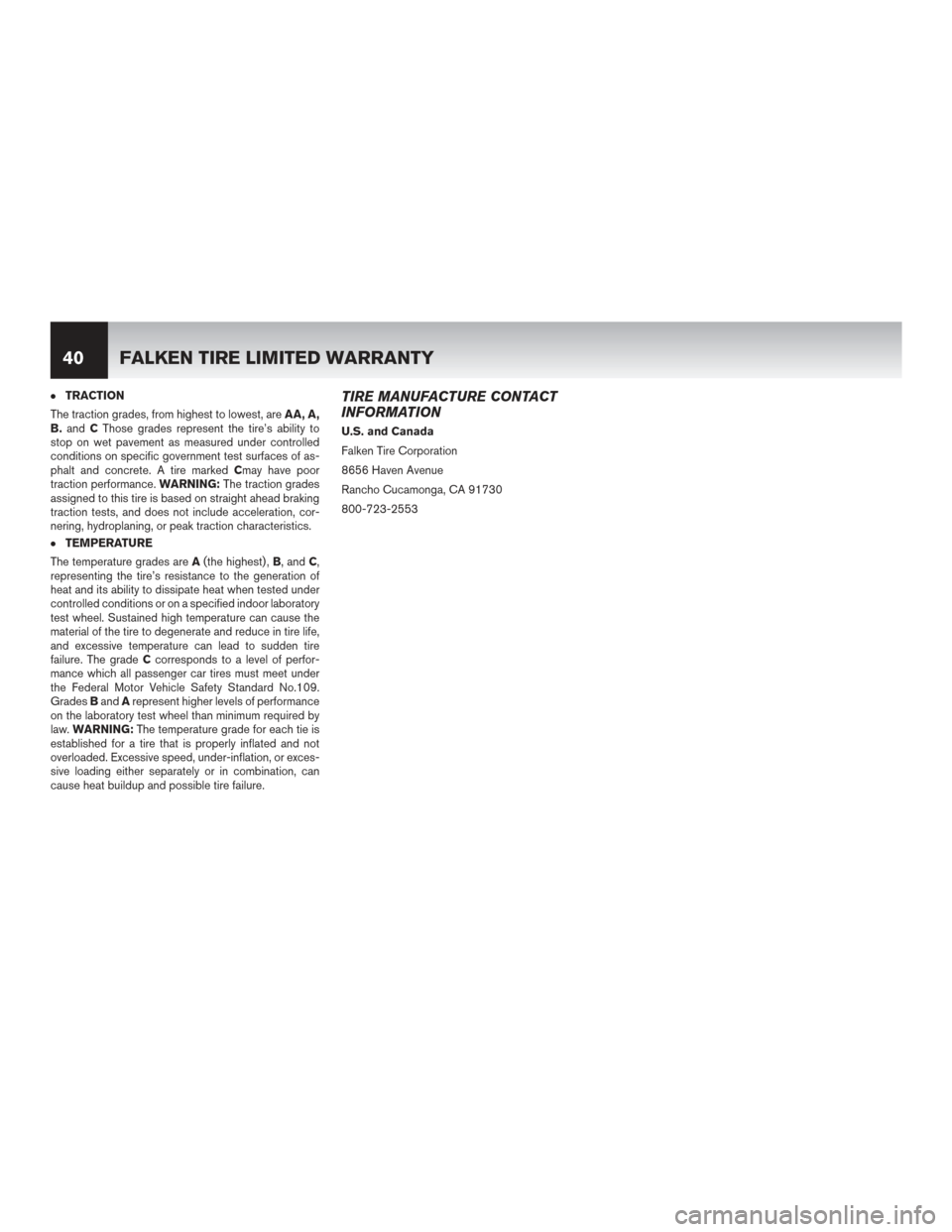
●TRACTION
The traction grades, from highest to lowest, are AA, A,
B. and CThose grades represent the tire’s ability to
stop on wet pavement as measured under controlled
conditions on specific government test surfaces of as-
phalt and concrete. A tire marked Cmay have poor
traction performance. WARNING:The traction grades
assigned to this tire is based on straight ahead braking
traction tests, and does not include acceleration, cor-
nering, hydroplaning, or peak traction characteristics.
●TEMPERATURE
The temperature grades are A(the highest) , B, andC,
representing the tire’s resistance to the generation of
heat and its ability to dissipate heat when tested under
controlled conditions or on a specified indoor laboratory
test wheel. Sustained high temperature can cause the
material of the tire to degenerate and reduce in tire life,
and excessive temperature can lead to sudden tire
failure. The grade Ccorresponds to a level of perfor-
mance which all passenger car tires must meet under
the Federal Motor Vehicle Safety Standard No.109.
Grades Band Arepresent higher levels of performance
on the laboratory test wheel than minimum required by
law. WARNING: The temperature grade for each tie is
established for a tire that is properly inflated and not
overloaded. Excessive speed, under-inflation, or exces-
sive loading either separately or in combination, can
cause heat buildup and possible tire failure.
TIRE MANUFACTURE CONTACT
INFORMATION
U.S. and Canada
Falken Tire Corporation
8656 Haven Avenue
Rancho Cucamonga, CA 91730
800-723-2553
40 FALKEN TIRE LIMITED WARRANTY